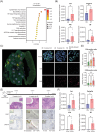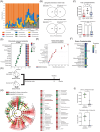A novel mouse model of upper tract urothelial carcinoma highlights the impact of dietary intervention on gut microbiota and carcinogenesis prevention despite carcinogen exposure
- PMID: 39693209
- PMCID: PMC11789449
- DOI: 10.1002/ijc.35295
A novel mouse model of upper tract urothelial carcinoma highlights the impact of dietary intervention on gut microbiota and carcinogenesis prevention despite carcinogen exposure
Abstract
Animal models of N-butyl-N-(4-hydroxy butyl) nitrosamine (BBN)-induced urothelial carcinoma (UC), particularly bladder cancer (BC), have long been established. However, the rare incidence of BBN-induced upper urinary tract UC (UTUC), which originates from the same urothelium as BC, remains elusive. The scarcity of animal models of UTUC has made it challenging to study the biology of UTUC. To address this problem, we tried to establish a novel mouse model of UTUC by treating multiple mice strains and sexes with BBN. The molecular consistency between the UTUC mouse model and human UTUC was confirmed using multi-omics analyses, including whole-exome, whole-transcriptome, and spatial transcriptome sequencing. 16S ribosomal RNA metagenome sequencing, metabolome analysis, and dietary interventions were employed to assess changes in the gut microbiome, metabolome, and carcinogenesis of UTUC. Of all treated mice, only female BALB/c mice developed UTUC over BC. Multi-omics analyses confirmed that the UTUC model reflected the molecular characteristics and heterogeneity of human UTUC with poor prognosis. Furthermore, the model exhibited increased Tnf-related inflammatory gene expression in the upper urinary tract and a low relative abundance of Parabacteroides distasonis in the gut. Dietary intervention, mainly without alanine, led to P. distasonis upregulation and successfully prevented UTUC, as well as suppressed Tnf-related inflammatory gene expression in the upper urinary tract despite the exposure to BBN. This is the first report to demonstrate a higher incidence of UTUC than BC in a non-engineered mouse model using BBN. Overall, this model could serve as a useful tool for comprehensively investigating UTUC in future studies.
Keywords: N‐butyl‐N‐(4‐hydroxybutyl) nitrosamine; animal model; cancer prevention; microbiome; upper tract urothelial carcinoma.
© 2024 The Author(s). International Journal of Cancer published by John Wiley & Sons Ltd on behalf of UICC.
Conflict of interest statement
The authors declare that they have no competing interests.
Figures






Similar articles
-
The interaction of arsenic and N-butyl-N-(4-hydroxybutyl)nitrosamine on urothelial carcinogenesis in mice.PLoS One. 2017 Oct 10;12(10):e0186214. doi: 10.1371/journal.pone.0186214. eCollection 2017. PLoS One. 2017. PMID: 29016672 Free PMC article.
-
Tissue-specific mutagenesis by N-butyl-N-(4-hydroxybutyl)nitrosamine as the basis for urothelial carcinogenesis.Mutat Res. 2012 Feb 18;742(1-2):92-5. doi: 10.1016/j.mrgentox.2011.11.015. Epub 2011 Dec 4. Mutat Res. 2012. PMID: 22155125
-
Commentary on "tissue-specific mutagenesis by N-butyl-N-(4-hydroxybutyl) nitrosamine as the basis for urothelial cell carcinogenesis." He Z, Kosinska W, Zhao ZL, Wu XR, Guttenplan JB, Department of Basic Science, New York University Dental College, NY, USA.: Mutat Res 2012;742(1-2):92-5 [Epub 2011 Dec 4].Urol Oncol. 2014 Feb;32(2):214. doi: 10.1016/j.urolonc.2013.08.014. Urol Oncol. 2014. PMID: 24445298
-
Review: BBN as an urothelial carcinogen.In Vivo. 2012 Jul-Aug;26(4):727-39. In Vivo. 2012. PMID: 22773588 Review.
-
The N-butyl-N-4-hydroxybutyl Nitrosamine Mouse Urinary Bladder Cancer Model.Methods Mol Biol. 2018;1655:155-167. doi: 10.1007/978-1-4939-7234-0_13. Methods Mol Biol. 2018. PMID: 28889385 Review.
References
-
- Siegel RL, Miller KD, Wagle NS, Jemal A. Cancer statistics, 2023. CA Cancer J Clin. 2023;73:17‐48. - PubMed
-
- Gontero P, Compérat E, Dominguez JL, et al. Non‐muscle‐invasive bladder cancer (TaT1 and CIS) EAU Guidelines on. 2023.
-
- Rouprêt M, Babjuk M, Burger M, et al. European Association of Urology guidelines on upper urinary tract urothelial carcinoma: 2020 update. Eur Urol. 2021;79:62‐79. - PubMed
MeSH terms
Substances
Grants and funding
LinkOut - more resources
Full Text Sources
Medical
Molecular Biology Databases

